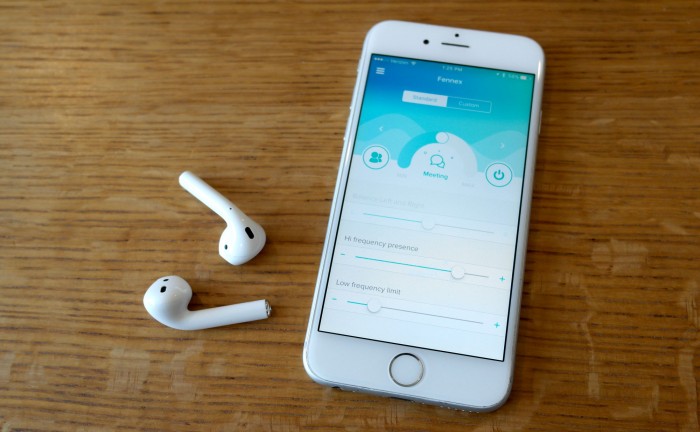How Your Apple Wireless Earbuds Could Double as Hearing Aids


What if a hearing aid could be replaced with a pair of wireless earbuds and a smartphone app?
A Swiss startup is trying to make this reality with an app called Fennex, recently released for the iPhone, that works with Apple’s $159 AirPods wireless earbuds. Alex Mari, CEO of the startup of the same name, says that he chose Apple’s devices and mobile platform for the app in part because of their popularity, but also because he thinks an Android phone would result in more latency when processing sound.
The Fennex app, currently free though it may eventually charge for certain features, is still in its earliest days. Mari says today’s version functions like a “cheap hearing aid”: it simply tests your hearing in each ear and uses those results to act as a personalized, adjustable amplifier. If you’re having trouble hearing in a class, for instance, you could place your phone near the lectern while you’re sitting a few rows back and listening in on a pair of AirPods.
But upgrades are coming, Mari says: the app is slated to gain features that will help reduce unwanted noise and feedback. And beyond helping people who just want to hear better in some situations, the software could eventually work with with Apple’s hardware to serve as a viable alternative to a regular hearing aid for people who have moderate hearing loss, he believes.
“We want to get as close as we can to hearing aid technology,” he says.
Fennex is latching on to a broader trend in using smartphones and earbuds to augment hearing, both for people with hearing loss and for those who simply want to adjust how they hear. Already, there are some similar apps that work with earbuds and smartphones, like Petralex, as well as specialized earbuds that work with their own smartphone apps, like Doppler Labs’ Here One. Unlike hearing aids, which can cost thousands of dollars for a pair, these so-called hearables may cost up to a few hundred dollars on top of the price of a smartphone.
Fennex claims to be the only one designed for the AirPods specifically. And since Apple is clearly moving away from the traditional headphone jack—it cut it out of the iPhones released last year and included just its proprietary Lightning connector for charging—it is possible that in the coming years AirPods will become a lot common.
Larry Humes, a distinguished professor of speech and hearing sciences at Indiana University Bloomington, is optimistic that something like Fennex could take the place of a traditional hearing aid for those with mild to moderate hearing loss. He thinks the recent passage of legislation that orders the FDA to create a new class of over-the-counter hearing aids could help, too, as he expects it will lead to a range of hearing-related products that people can get without needing to visit a doctor.
However, as Mari knows, it’s clearly a risk to focus on making software for one pair of earbuds, since Fennex can’t control what Apple does with its hardware or the access it gives to developers who want to develop software that works with it.
There’s also the issue of hearing delays. Fennex works by using the AirPods’ microphones to record sounds in the world around you, after which it sends the audio to the iPhone app for processing and then back to the earbuds. The delay, for now, is 130 milliseconds, which might be fine for listening but is noticeable if you’re trying to engage in a conversation.
Keep Reading
Most Popular
Large language models can do jaw-dropping things. But nobody knows exactly why.
And that's a problem. Figuring it out is one of the biggest scientific puzzles of our time and a crucial step towards controlling more powerful future models.
The problem with plug-in hybrids? Their drivers.
Plug-in hybrids are often sold as a transition to EVs, but new data from Europe shows we’re still underestimating the emissions they produce.
How scientists traced a mysterious covid case back to six toilets
When wastewater surveillance turns into a hunt for a single infected individual, the ethics get tricky.
Google DeepMind’s new generative model makes Super Mario–like games from scratch
Genie learns how to control games by watching hours and hours of video. It could help train next-gen robots too.
Stay connected
Get the latest updates from
MIT Technology Review
Discover special offers, top stories, upcoming events, and more.